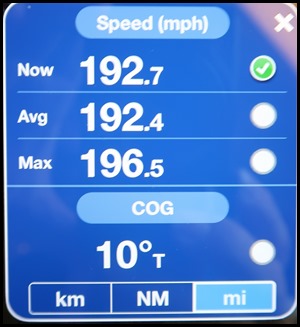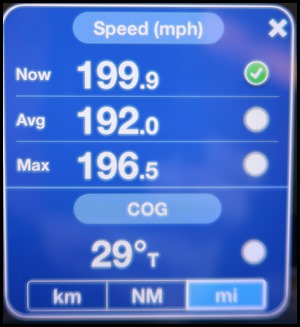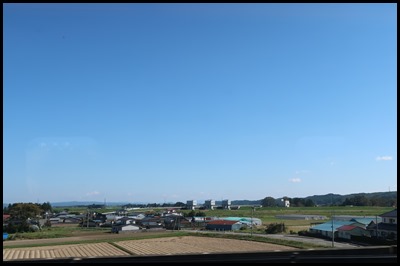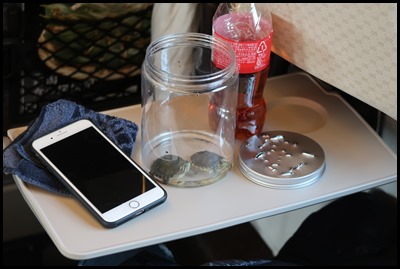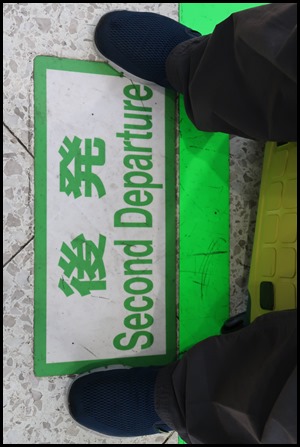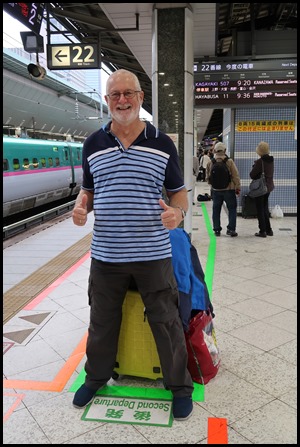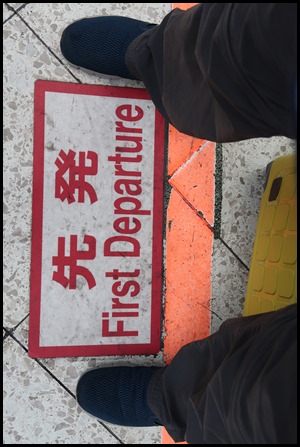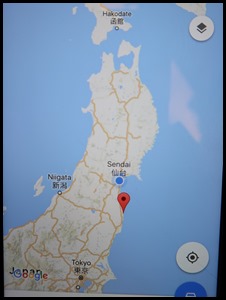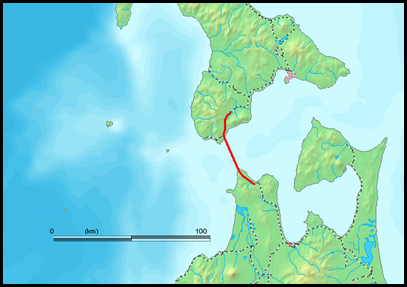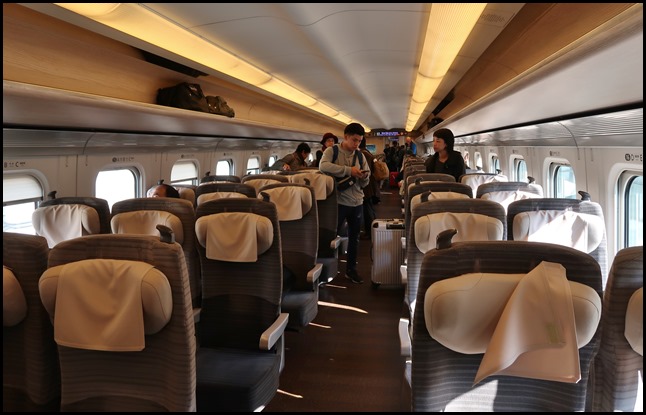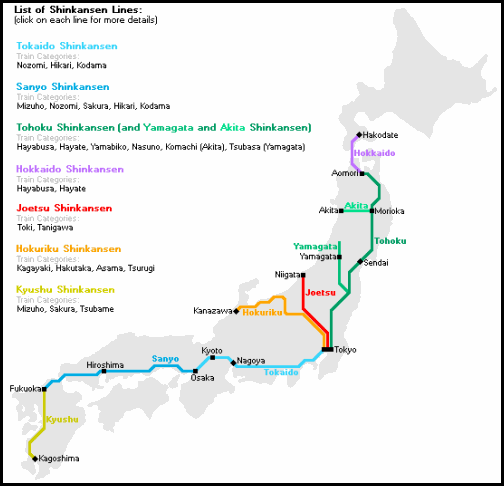First Bullet

|
Our First Ride on the Bullet
Train – the Fastest One in Japan (as it happens) - The
Hayabusa
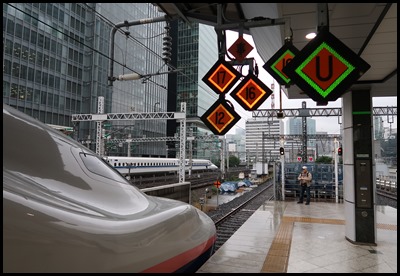 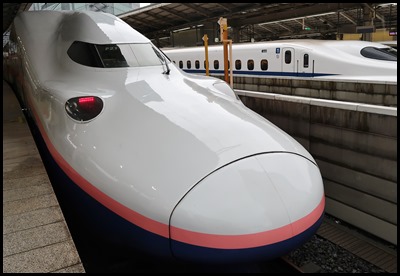 We transfer from our local express,
bimble to the Shinkansen platforms and see a beast
that’s purring. A closer look. Ooooooo.
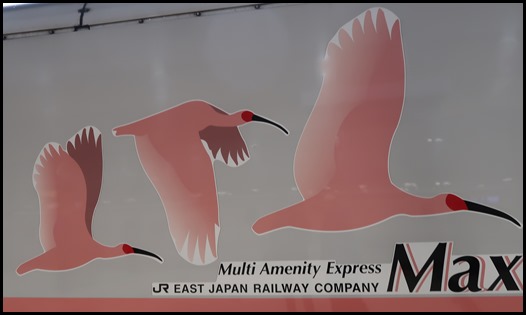 Loving the crane
decals on Max.
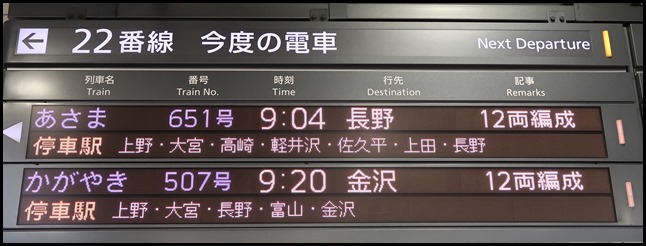 Our 9:20 train appeared on the overhead board as the 9:04 came in with a
shuuuuuuuuuuuush.
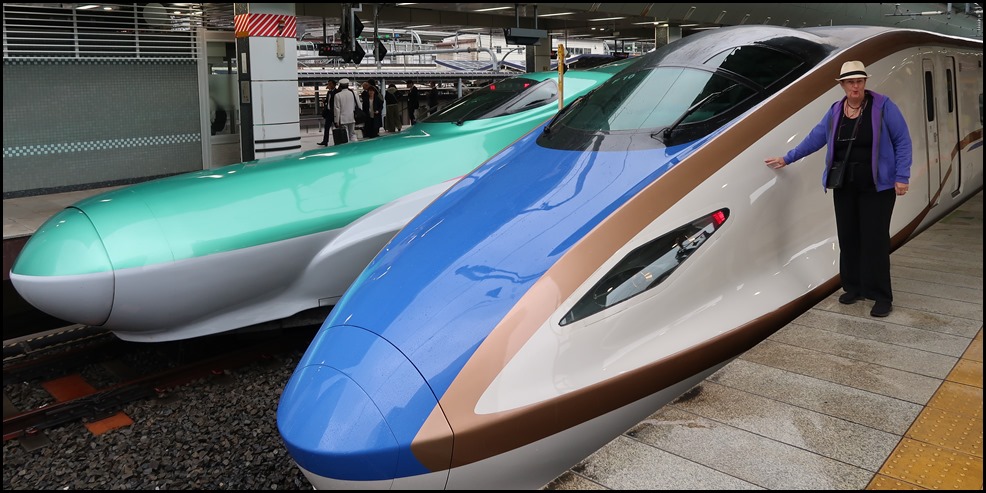 I had to go to the front for a closer
look and couldn’t help the Oooooo, just touching this
sexy beast (no other words do justice). Ours, when he arrives, yes, they are
definitely a he, will look like the peppermint coloured beast.
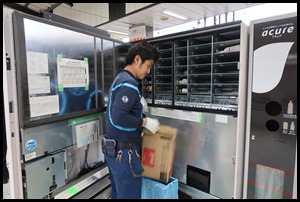 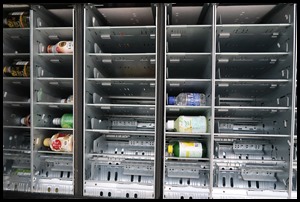 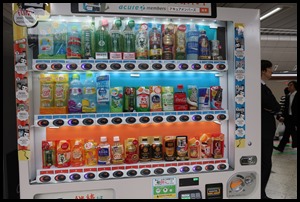 We watched in amazement as the vending machine near us was filled. The lad knew where
everything went and within minutes al the empty slots were filled, boxes
flattened and packed on the trolley and off he went.
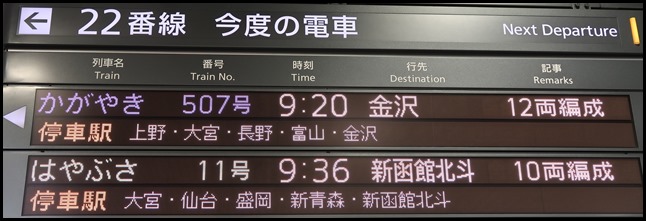 Our train went to
the top. Real excitement brewing betwixt the Millards.
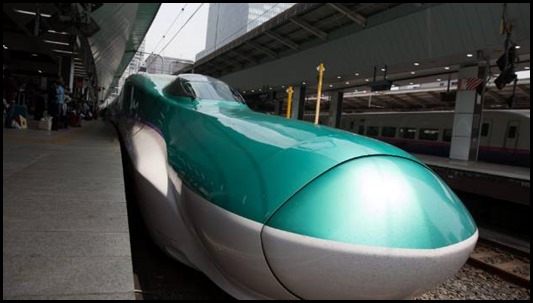 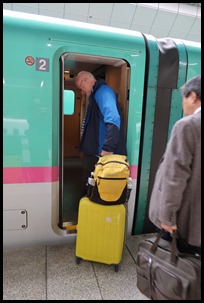 I was so busy videoing our train coming in as well as recording how the seats all
change direction at the press of a switch, that I didn’t actually take any
photographs. Well, here’s one I borrowed. I did get one of Bear boarding his first ever bullet train
though.
Researching this blog I found an
article that sums up the essential points. Here it is:
Five things to know about Japan's Shinkansen: The trains that always run on time AISHA DOW - Aisha travelled to Japan as a guest of the Ministry of Foreign Affairs of Japan. Aisha is an Australian journalist. Last updated 12:51, November 11 2016 In 1964 the Japanese launched the world's first high-speed rail line. With an operating speed of 210km/h, it would still put our "modern" train services to shame. More than half a century later, the island nation is eager to export its technology to other parts of the world. And the key selling points of the Japanese fast train are a matter of great national pride.
Leaving a very wet, grey Tokyo behind.
1. The Shinkansen always run on time The average delay of the nation's fleet of bullet train, known locally as the Shinkansen, is less than 60 seconds. Believe or not, this statistic also includes unavoidable, major delays such as typhoons and earthquakes. "I think it's fair to say the Shinkansen always run on time," said Nobukazu Nagai, a director with the Japanese Ministry of Land, Infrastructure, Transport and Tourism. In a requirement that most would probably consider – well, embarrassing – Shinkansen drivers are trained to talk to themselves throughout their journey, continually logging how they are performing to schedule. "Ten seconds of delay departure," they will bark out loud, to no one in particular, also pointing with white-gloved hands to a traditional pocket watch that is propped up on the dash. The Shinkansen can travel many hundreds of kilometres in any one journey, but if a train arrives more than one minute late to its destination, the driver will have to give a formal explanation.
Bear was thrilled at 192.7 mph. Our fastest for just a little while was 199.9, how I hoped our driver would sneeze and jog us to 200. 2. Flying trains The fastest current operating speed of the Japanese bullet train is 320kmh. While Japan no longer has the fastest commercially-operating passenger train on earth (China does at 431km/h), it's attempting to win back the crown, with a new type of super-fast train, perhaps better described as an aeroplane train. For most of its journey, the magnetic levitation train does not make contact with the ground, but hovers 10 centimetres above as it's propelled through the air with electrically-charged magnets on either side of the track. Just like a plane, its wheels go up when it gets up enough speed. The Central Japan Railway Company has begun construction on a $65 billion magnetic levitation line between Tokyo and Nagoya. SC Maglev trains on this route, expected to be in operation by 2027, will have operating speeds of 500km/h, though trains on a test line near Mount Fuji have already reached more than 600km/h, breaking world speed records in the process.
Sunshine and blue sky out in the countryside. A chuffed Bear. Too right.
3. 51 years accident free No passenger has been killed in a Japanese bullet train crash since they first rolled out more than half a century ago. Type "Shinkansen crash" into Google and you'll only find a few scraggly stories about a Japanese bullet train that hit a car, killing the driver, and some accounts of the not-uncommon cases of suicide by train. Elsewhere in the world hundreds of people have been killed in high-speed rail catastrophes. Germany's Intercity Express had an unblemished fatality record for just seven years before 101 people were killed when one of its trains derailed at 200km/h in 1998.
The chaps in the seat in front of us enjoying the smooth ride.
4. The seven-minute miracle No one who visits Japan would dispute that the Shinkansen are impressive machines. If you're lucky enough to witness a long-nosed Shinkansen roaring through a station at full speed, you will experience the monstrous roar it makes that rattles you to the bones, and can only evoke comparisons to some sort of mythical being. But so much of the success of the Japanese fast train and their efficiency is tied to the Japanese themselves.
For example, even the passengers exhibit a special type of discipline. Alongside the trains there are lines painted on the ground, one column labelled "first" for the next train and the other "second" for one after. Instead of lounging wherever they so please on the platform, everyone politely lines up in order of arrival within the appropriate painted line. Then there is the so-called "seven-minute miracle", named after the efficient train cleaners who wait in lines beside the train. Wielding squeegees, the women in pink and men in blue will bow deeply to the train as it arrives and then bow repeatedly to all the passengers who disembark, before running through the cabins, wiping down trays and collecting rubbish. All this takes just seven minutes, allowing the Shinkansen to quickly turn around for another major journey.
We enjoy watching our progress on Bear’s phone.
5. Better than air travel? In the battle between the Shinkansen and the airlines, the Japanese talk about the magic 800-kilometre mark. Any less than 800 kilometres, most prefer to travel by fast train, any more then it is the aeroplanes that have the edge.
Nearing the end of our journey we go under the Seikan Tunnel.
The Seikan Tunnel is a 53.85 kilometre (33.46 mile) dual gauge railway tunnel, with a 23.3 kilometre (14.5 mile) long portion under the seabed. The track level is about 100 metres (330 feet) below the seabed and 240 metre (790 feet) below sea level. It extends beneath the Tsugaru Strait - connecting Aomori Prefecture on the main Japanese island of Honshu with the northern island of Hokkaido - as part of the standard gauge Hokkaido Shinkansen and the narrow gauge Kaikyo Lineportion of the Hokkaido Railway Company (JR Hokkaido)'s Tsugaru-Kaikyō Line. The name Seikan comes from combining the on'yomi readings of the first characters of Aomori, the nearest major city on the Honshu side of the strait, and Hakodate, the nearest major city on the Hokkaido side. The Seikan Tunnel is the world's longest tunnel with an undersea segment (The Channel tunnel, while shorter, has a longer undersea segment). It is also the second deepest and the second longest main-line railway tunnel after the Gotthard Base Tunnel in Switzerland opened in 2016.
Our three and a half hour journey comes to an end, our carriage non the worse for wear other than a couple of headrest covers being a little squiffy – the magic of the cleaning crew will sort that out in a trice.
The bullet train routes. By the time we leave Japan we will have travelled on both blue routes. Today, it was dark green and purple. How simply wonderful. Indeed Sir, indeed.
ALL IN ALL JUST FIVE YEARS AFTER THE MINI........AMAZING CHILDHOOD DREAM COME TRUE |

